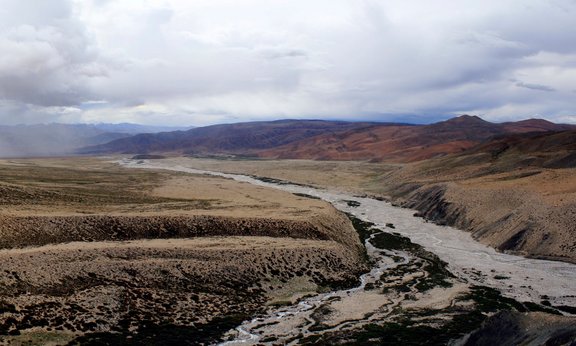Rainfall as well as snow and glacier meltwater dominate the water load of mountain rivers with different seasonal lags, and all three change as the climate warms. Precipitation patterns and intensities will change, snow will fall less frequently than rain, glaciers will lose mass, which means temporarily more and then less and less water supply to rivers. The different interplay of these three main components leads to very different runoff patterns, especially in the most powerful mountain range on earth, the Karakoram-Himalayan chain, which separates the Indian subcontinent from the Tibetan plateau and ranges from dry westerly winds in the northwest to summer monsoons in the southeast. An international group of scientists has assembled findings from about 250 individual studies on the current runoff patterns, the changes to be expected under climate change and the impacts on the population in the Karakoram-Himalayan region. The respective assessment was recently published in Science. The picture, which is composed of large-scale studies and those on sub-catchments like a jigsaw puzzle, essentially confirms an earlier study by the Innsbruck glaciologists: In the dry west and northwest, the glaciers dominate, and above all in the southeast, the rain from the summer monsoon increasingly dominates. Accordingly, the ice loss of the glaciers will mainly change the discharge of the Indus, but the shift of the monsoon patterns will change the Ganges, Brahmaputra, Irrawaddy and the major Chinese rivers.
Identifying and closing gaps
The new study clearly shows the gaps in knowledge about the three most important hydrological variables, but also about those of other hydrological variables such as evapotranspiration, groundwater and permafrost, and points out ways to close them. To this end, the researchers recommend expanding the observation network and developing model comparison projects. "Hazards such as glacial lake outbursts and major changes in the timing and amount of runoff in glaciated basins are some of the changes that people in the Himalayas are already experiencing," adds Fabien Maussion, assistant professor at the Department of Atmospheric and Cryospheric Sciences and co-author of the study. "Coordinated international efforts are needed to provide more accurate forecasts for local stakeholders and policy makers."
The best possible knowledge of the present composition of runoff components as a prerequisite for understanding and predicting future water availability in the catchments of the major rivers from the Karakoram-Himalayan chain is the indispensable basis for conservation and adaptation strategies. This review paper is an essential guide for urgently needed more intensive scientific research as well as an important reference for international, national, regional and local decision makers in the region. The University of Innsbruck is part of a large international consortium - financed by the European Union in the framework of Horizon 2020 - to quantify the potential consequences of exceeding the climate targets in the Paris Agreement for local communities, such as those in the Indus Basin. Work on this will begin in September this year.
Links
- Azam MF, Kargel JS, Shea JM, Nepal S, Haritashya UK, Srivastava S, Maussion F, Qazi N, Chevallier P, Dimri AP, Kulkarni AV, Cogley JG, Bahuguna IM. Glaciohydrology of the Himalaya-Karakoram. 2021. Science. eabf3668. https://doi.org/10.1126/science.abf3668
- Department of Atmospheric and Cryospheric Sciences (ACINN)
- Fabien Maussion

